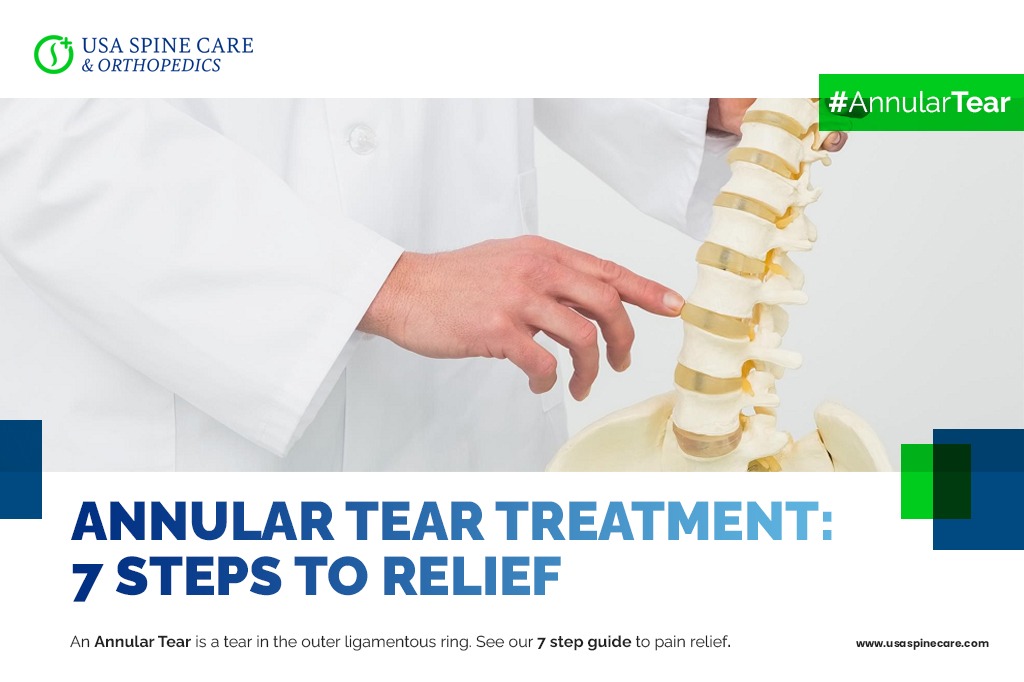- Conditions
- Procedures
- Patient care
- Why choose us
- Our Doctors
- Contact
Annular Tear Treatment: Four Steps to Relief

Patients who are diagnosed with an annular tear often find themselves with a lot of questions about treatment. One reason for this is that like many spine conditions, an annular tear has the potential to sound like a more serious condition than it is. Which is not to say that this condition does not cause serious symptoms and that patients should ignore treatment when an annular tear occurs.
However, although the term seems to imply an injury that involves sudden tearing, annular tears are actually far more commonly related to the natural aging process. An annular tear occurs when one of the rubbery vertebral discs that helps to cushion the spine develops a tear in the outer layer, which is called the annulus. An annular tear is often closely related to a condition called degenerative disc disease, which describes the natural process that causes vertebral discs to become brittle and prone to cracks and tears.
Although an annular tear can be a difficult diagnosis, there are a wide range of highly effective management and treatment options. By learning more about what is available, you can actively engage as you seek the lasting relief you deserve. That’s why the USA Spine Care team is happy to share the following information. We also invite you to reach out if you’d like to learn more or have any questions at all.
Step one — understanding annular tears and basic treatment options
The spine is essential to both supporting the upper and protecting the central nervous system. The vertebral discs help in this function by cushioning the vertebrae, allowing the spine to bend and flex. Over time, the discs lose water content due to natural aging, making them less elastic and brittle. This can lead to the development of small cracks in the outer layer that can eventually turn into tears, which are annular tears.
Annular tears are very common and may not even cause symptoms. Doctors only recommend treatment when diagnosing an annular tear that is causing pain due to either irritation of local nerves or if the vertebral disc is causing compression of the spinal cord or a nerve root.
For many patients, annular tear symptoms often respond to basic conservative treatments, including:
- Periods of rest
- Applying cold compression, such as an ice pack
- Using a heating pad to improve circulation and relax tense muscles
- Over-the-counter medication, particularly nonsteroidal anti-inflammatory drugs
Annular tears that aren’t symptomatic at first can also develop into more advanced conditions such as herniated or bulging discs, particularly since degenerative disc disease is so often an underlying condition.
Step two — committing to a spine-healthy lifestyle
Focusing on spine health is important because it can help with annular tear symptoms while also lowering the risk of the tear worsening or other related spine conditions developing. Effective ways to improve spine health include:
- Reducing the stress on the spine by losing excess body weight
- Improving posture to evenly distribute weight on the discs
- Get regular exercise to strengthen supporting muscles and improve circulation
- Eat a healthy and nutrient-rich diet
- Avoid tobacco products and excessive alcohol consumption
Step three — exploring additional conservative therapies
If pain and other symptoms related to an annular tear become disruptive to daily activities and quality of life, many patients explore more involved conservative treatment options. Physical therapy can be highly effective for improving spine function and relieving pain related to conditions such as an annular tear. By working with a licensed and experienced physical therapist, patients can improve range of motion and strength in the neck and back, which are essential to overcoming annular tear symptoms.
Another common option are therapeutic injections, typically consisting of a corticosteroid and numbing agent, that help to relieve inflammation around the vertebral disc. Patients often report experiencing significant relief for a period of weeks or longer, which can help promote increased activity and assist with physical therapy.
Step four — knowing when to consider annular tear surgery
Surgery is generally seen as a last resort treatment option for annular tears, and often when the tear has progressed to a herniated disc or if there is severe degenerative disc disease. However, if weeks or months of conservative treatment have not offered relief, a minimally invasive outpatient procedure can offer the best chance of long-term relief and returning to a healthy and active lifestyle in many cases.
To learn more about the treatment options available at USA Spine Care & Orthopedics, from physical therapy to spinal injections, contact our caring and dedicated team today.
Annular Tear Quick Answers:
Do annular tears require surgery?
A diagnosis of an annular tear does not indicate surgery in a very large number of cases. Patients with an annular tear can often successfully manage the condition through conservative treatments and lifestyle adjustments.
Can annular tears heal by themselves?
It is possible for individual annular tears to improve over time and with treatment. However, the underlying causes of annular tears are natural degenerative forces that are not reversible. Committing to treatment and a spine-healthy lifestyle are the best ways to lower the risk of annular tears.
How long does an annular tear take to heal?
The biggest hurdle to annular tear healing is the limited blood supply that the vertebral discs receive. This can mean that annular tears can often take months or longer to heal. Patients with an annular tear should be prepared to commit to conservative treatment and lifestyle changes to ensure the best chance of speedy healing.
What are the treatment options for an annular tear?
Doctors first recommend conservative treatments upon diagnosis of an annular tear. Rest, over-the-counter medication, physical therapy and therapeutic injections can all be highly effective. Surgery can be a serious consideration if the tear worsens or doesn’t respond to conservative treatment.
